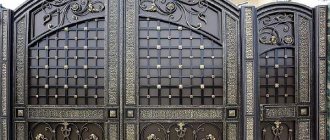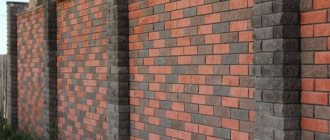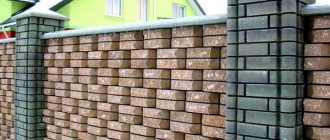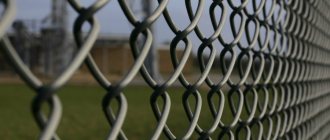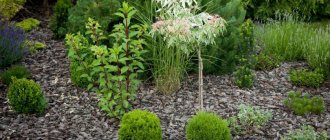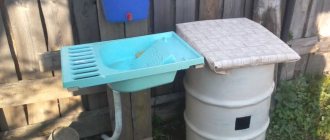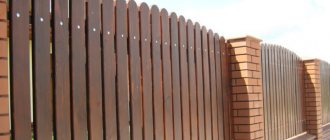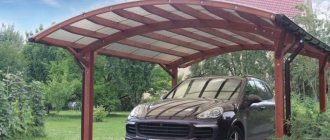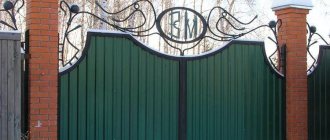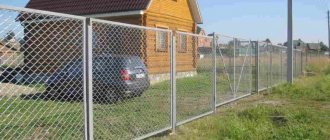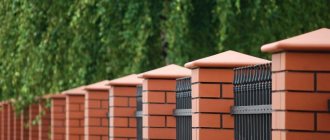The most convenient supports for fences are made of metal. They are able to withstand structures of any weight, are durable and inexpensive.
To choose metal fence posts, you need to correctly calculate the length and take into account the load. The method of fastening the racks depends on the type of soil and sectional material.
Users often search for:
- Wooden fence posts: installation, protection
- Fence made of crushed stone and mesh
Installation of wooden poles
Made from solid logs, such poles will be quite expensive, especially if they are high-quality samples from hardwood. Pine, mulberry, oak and larch have the best properties in terms of resistance to natural factors and the effects of mold and fungi.
Pine and fir are also used in the production of poles. But birch, aspen, beech or alder are not used. In addition, before installation, wooden poles must be treated with an antiseptic and burned to the charring stage. It is advisable to use such supports for wooden fences.
If you decide to use wooden supports, then you need to choose them with a diameter of at least 150 mm; for intermediate installation you can take 100 mm.
They are treated with a solution of copper sulfate or other antiseptic, and the lower edge is treated with resin, followed by coating with roofing felt material. Painting with oil paint will also be useful. And it must be installed with the top down.
The holes are drilled with a diameter twice the size of the support. With a ground height of 1.5 m, the depth must be at least 0.5 m. Remember, for strength, at least a third of the length of the entire support must be buried.
Before installing the pillar, you should arrange a drainage cushion from a layer of crushed stone or expanded clay. After strictly vertical installation, the pit is filled with crushed stone and fragments of bricks. During the work process, compulsory compaction is carried out.
The strength of the fastening can be ensured by using metal sleeves with a diameter smaller than the size of the post. A wooden log is inserted into a metal tube.
How to Use Steel Pipe as a Fence Post
When using steel pipe as a support for a fence, it is important to ensure that the preparatory step is done correctly. The work is carried out according to the following principle diagram of the installation of pillars:
- Before digging in, the metal is treated to remove rust.
- On the recessed part, reinforcing reinforcement is welded independently.
- On the open part, hooks are welded under the chain-link mesh, plates with eyes under the horizontal logs. It is also possible to weld the logs directly to the pipe after installing the pole in the ground.
- To protect against subsequent rusting, the steel pipe is primed and painted with weather-resistant paints.
- The posts are being installed and the fence sections are being secured.
Metal constructions
Such supports are not only distinguished by their versatility and applicability for various types of fences, but also by their high strength. This is a durable material, but the pipes must be treated with anti-corrosion agents. Regular coloring is also required.
There are two types of supports:
- hollow welded round shape;
- made of metal profiles with a square cross-section.
The optimal diameter of the pillars will be 60 mm with a wall thickness of at least 2 mm. The strength of the material ensures that the fence is resistant to various types of loads, including wind. For installation, concreting methods are used, or supports are driven into the ground.
It is advisable to install fence posts by concreting in areas with sandy soil, as well as if the soil is susceptible to heaving. Two technologies are used:
- a hole is drilled with a size slightly larger than the diameter of the support, then a pole is placed, and the gap between it and the walls of the hole is filled with concrete;
- After drilling the hole, concrete is placed in it, and only then the support is placed vertically, providing a more durable fixation.
If the site has heavy, dense soil or you plan to use a fairly lightweight fencing structure, then you can use the technology of driving in supports.
First you need to drill holes. But their diameter should be less than the size of the pillars. Then the supports are driven into the holes with a sledgehammer.
The distortion can be eliminated with blows of a sledgehammer. To simplify the installation procedure, you can use poles with a helical spiral for screwing into the ground.
Metal screw piles for fence
A screw pile is a rolled pipe product with a round cross-section. Its difference lies in the presence of a sharp conical tip and spiral blades at the bottom of the structure. For fences, two standard sizes of piles are used - with a diameter of 57 and 76 mm, although there are larger diameters. The length can be 2.4 m and 3.0 m.
The screw pile is perfect for fences with any section filling. Can be buried into the ground up to 2 meters. The method of installing it is similar to working with a corkscrew: deepen the screw by rotating the stand clockwise. Due to the blades, the support is screwed into the ground. The rotation is carried out with a special wrench, which can also be purchased ready-made.
Asbestos-cement and concrete fastenings
Asbestos-cement supports are a durable, but expensive option for arranging fencing. Moreover, if water gets into the empty space of the pipes, there is a risk of rupture. Also, this material is not used with all types of fencing.
The concrete structure will be very heavy, but these supports are strong, reliable and durable, since they are not affected by most environmental factors. Due to their weight and high price, they are rarely used - mainly for very massive structures.
Asbestos-cement pipes are usually taken with a diameter of 120 mm. A two-meter pole requires a depth of at least 800 mm. The lower part of the pit must be made with an extension, which must first be filled with concrete. Roofing felt is used to insulate walls. Moreover, the insulating material should protrude outward by 150-200 mm.
A wooden formwork is installed around the ground part of the roofing felt, and then the pit begins to be filled with concrete. A bracket in the form of a metal rod is inserted into the solution until it hardens completely.
The length of the pin should be less than the length of the support. An asbestos-cement pipe is strung vertically onto it, and the cavity inside is filled with concrete solution. A rounded cap is made at the top to allow water to drain.
What types of fence supports are there?
To choose the right material and installation method for fence posts, it is important to consider the following factors:
- aesthetics and harmonious design;
- resistance to the negative effects of overheating and freezing, sun, moisture and other factors;
- durability and wear resistance, which depends on the conditions of use;
- strength and ability to withstand the fence fabric.
Before you start designing and installing a fence, it is important to figure out how much you are willing to invest in the construction, what kind of design you want to make, and also identify the characteristics of the soil on which the structure will be located. It is important to remember that over time, the soil may undergo changes under the influence of various natural factors, which can negatively affect the functioning and appearance of the fence.
All fences are traditionally made from materials of varying strength and weight:
- made of plastic and other similar materials;
- picket fences made of wood or plastic;
- from welded rods or forging;
- from twigs and vines;
- from a chain-link mesh;
- from corrugated sheets and sheet metal;
- made of red and sand-lime brick;
- made of concrete and stone.
The choice of supports for it also depends on the material and design of the fence. Moreover, this element will become another decorative detail or will be hidden from prying eyes. Experts distinguish the following types of fence posts:
- Made of wood. In order for the fence to last as long as possible, wooden posts must be made of durable and not susceptible to destruction of wood species, treated with special means (antiseptics or burned until charred). This material, although considered traditional, is quite expensive. The pillars are made from solid logs, most often made from pine, oak, larch, acacia, mulberry, fir and spruce, ash. You should not make supports from beech, aspen, birch, linden, alder, or beech.
- From pipes or profiles. This type is suitable for almost any canvas material and can withstand heavy loads. With proper rust treatment and proper care during operation, such supports will last a very long time and retain their good appearance. Metal pillars come in round and square sections, can have different diameters from 2 cm and wall thickness from 2-3 mm.
- Asbestos cement and concrete columns. This type of support is also durable, but is quite difficult to install, has a high cost and is not compatible with all types of fence fabric. In addition, they can be damaged due to temperature changes and freezing-thawing of water that gets inside through the uncovered top. This type of pillar is used more often to provide a certain design solution with its inherent color and appearance.
- Made of brick. Can be of different sizes. This type is distinguished by the complexity and duration of installation, the need to contact professionals, and therefore higher cost. The durability of such a structure most often depends on the masonry and taking into account all the features of the fence and the soil under the post.
Important! Each type must be correctly installed, taking into account all necessary factors. Next, we will look at the features of installing supports from all possible materials.
Installation of brick pillars
This is a visually attractive design, but installation requires strict adherence to technology. A foundation for the load is required.
To install fence posts with your own hands, you need to lay a strip foundation. To do this, a trench is dug and brick fragments are placed in it. Concrete solution is poured on top.
For the post at the place of its subsequent installation, a frame is equipped in the form of reinforcement made of metal rods or pipes. Roofing felt is laid on top of the foundation. Brickwork is done around the frame. The internal cavity must be filled with concrete.
How to concrete the pillars so that they do not stick out?
The most reliable method of installing fence posts is concreting using plastic pipes. This option for installing supports is more expensive than the standard one, however, the reliability of this design is much higher. To install the supports, you will need to purchase additional plastic sewer pipes. Their diameter should be 110 mm and length 1 m.
This option for installing poles is suitable for regions where the depth of soil freezing exceeds 1.2 m. The pole must have a length greater than this indicator. Let's consider the process of concreting supports with plastic pipes in stages.
First you will need to make holes for the supports. A hand drill is used for this. Next, the part of the pillar located below the plastic pipe is concreted.
Then you need to cut the plastic pipe. The expanded section is removed, after which the length of the pipe is reduced to 85 cm. The top of the pipe should be approximately 15 cm above the soil level. The remaining 70 cm are located in the soil above the concrete base. At the next stage, the cavity of the plastic pipe is filled with a sand-gravel mixture.
Note! In winter, the soil raised by heaving will slide along the pipe, which will protect the pole from distortion.
To prevent the pillars from sticking out, it is recommended to pour concrete inside them. If you leave the cavity open, then water can penetrate into it, which will negatively affect the material.
Interesting: How to prepare concrete: proportions
Tips for arranging supports
Along the perimeter of the future fence, you need to install stakes in place of the supports and pull the rope. The placement of pegs must be strictly aligned. The distance between the pillars is up to 3 m, and for heavy structures no more than 2.5 m. For extreme, corner supports, pipes of larger diameter are selected. This will ensure the stability of the structure before loading.
First you need to sequentially install the corner posts and check their height matching using a level. Twine is pulled from below and above between the pillars. It will help you position the intermediate supports evenly.
Installation will be more difficult if the height difference in the area is more than 250 mm. In this case, you need to install additional supports and arrange a stepped structure. In areas of the fence where it is planned to install a wicket or gate, it is necessary to install additional posts for greater reliability.
It is mandatory to check the structure vertically with a level. This way you will get the correct fence, as shown in the photo of the fence posts. Fastening the fence itself should begin no earlier than 3-5 days from the moment of concreting.
Particularly dangerous are areas with heaving soil or high water levels. In this case, it is possible for the supports to be pushed out of the soil over time or to undergo putrefactive and corrosive destruction.
If you are faced with a groundwater problem, then you need to dig a trench or drill a hole deeper, i.e. lower relative to the water level. In this case, you will need to prepare a significantly larger volume of solution.
Experts also recommend constructing a high-quality drainage pad. Crushed stone with expanded clay is placed in the pits in a layer of at least 200 mm. Then a pillar is placed, and the gap between the pit is filled with crushed stone. But not completely, but with a shortfall of 150 mm. Concrete is poured from above the pillow to ground level.
You can install fencing on the territory of a country house yourself. To do this, you need to select supports that match the fence material, and then install them, following our simple instructions.
Materials for making fence posts
Fence posts have different configurations, load-bearing capacity, decorative properties and durability. The combination of these parameters depends on the material used to make the fence post. The most popular supports for fence construction are supports made from the following materials:
- Metal;
- Tree;
- Asbestos cement;
- Concrete;
- Brick.
The choice of a specific pole option should be based on the characteristics of the enclosing structure: its height, weight, intersectional distance, type of span filler. Not unimportant criteria are the operating conditions and the type of soil where it is planned to install the fence.
Photo of fence posts
Asbestos cement pipes
Such supports have a fundamental difference from wooden poles. They never rot. These pipes have an ideal geometric shape, they do not require special equipment for installation, and they are highly durable. If all technological installation conditions are followed, asbestos-cement pipes will serve for many years.
The disadvantage of this material is the difficulty of attaching the lags. This requires making special brackets and long pins.
The process of installing asbestos cement pipes for the fence
Since such material has increased fragility, it is necessary to be very careful when fixing them in the soil and subsequent concreting of the pillars.
Poles made of this material must be equipped with covers to protect the fence pipe from moisture getting inside the pipe. If the water freezes, it will begin to expand and the pillars will collapse.
Asbestos cement pipes can be classified as economical. This material is highly durable and never rots. Unfortunately, it is difficult to install logs on such pipes; additional work has to be done, which increases labor intensity.
Return to contents
Thickness of metal pillars
Metal is a durable substance, but capricious, susceptible to corrosion and requires protection. The service life of your fence depends on the thickness of the metal. Depending on the environment and weather conditions, the corrosion rate of metal intake pipes ranges from 0.01 to 0.5 mm per year, depending on the quality of the metal and its compliance with GOST.
So, for example, with a thickness of metal poles of 2 mm, if we take the average indicators of metal rotting, after 10 years, untreated pipes will rust and begin to crumble, and the fence will collapse along with them.
Despite the fact that primer and good painting protect the poles from the outside, they remain unprotected inside, which means that if moisture gets in there, corrosion is inevitable.
I was once offered cheap used fence posts, metal 3 mm thick - naturally I didn’t take the risk - I refused. I don’t know how many years they were used before that. My opinion is that you should not skimp on poles - they are supports that should last many times longer than the material for the fence.
If you are installing a temporary fence, which you plan to later replace with a more durable one, then there is absolutely no point in bothering with thickness. The metal will last up to 5 years even if you don’t process it.
At what distance are the pillars installed?
One of the most important stages in fencing an area is marking the site where the fence will be built. Proper marking will allow you not to overpay for extra purchased materials and tools. You can calculate the length of the fence span by measuring the full length of the fence, using pegs around the perimeter and stretching the twine between them. The standard distance between supports is considered to be 2.5-3 m. If a distance exceeding these parameters is adopted, the section web will not withstand wind loads well and may fall. If the distance taken to install the fence is less than the norm, then the fence will have increased strength and stability, but the owners will have to spend money on purchasing additional materials, which will greatly increase the cost of the fence.
